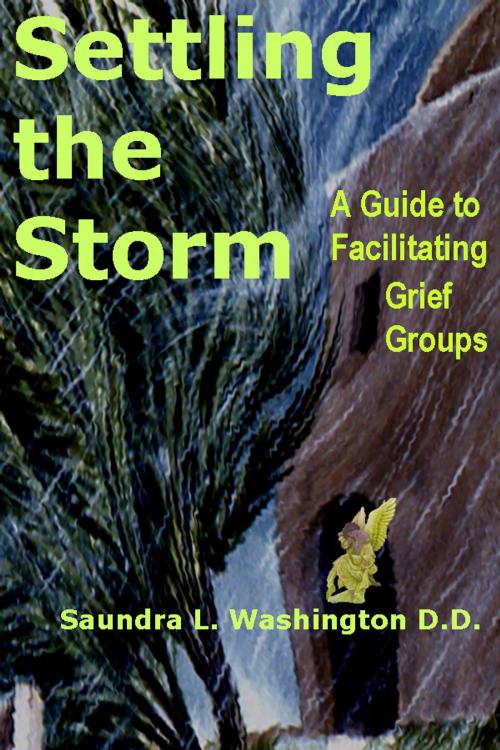Settling the Storm: A Guide to Facilitating Grief Groups
Nonfiction, Health & Well Being, Medical, Ailments & Diseases, Mental Health| Author: | Saundra L. Washington D.D. | ISBN: | 9781458121455 |
| Publisher: | Saundra L. Washington D.D. | Publication: | April 23, 2011 |
| Imprint: | Smashwords Edition | Language: | English |
| Author: | Saundra L. Washington D.D. |
| ISBN: | 9781458121455 |
| Publisher: | Saundra L. Washington D.D. |
| Publication: | April 23, 2011 |
| Imprint: | Smashwords Edition |
| Language: | English |
Technically, there are two types of grief groups. The informative/supportive grief groups’ purpose is to promote grief education and awareness. It covers grief and bereavement in a more didactic fashion.
The second type of grief group is therapeutic in nature. It is personal growth oriented groups focusing on facilitating the individual participant’s own personal loss process. Though many commonalities exist between these two types of groups each has its own unique dynamics and concerns. This book focuses on the second type of group, sometimes referred to as Grief Recovery Groups. I prefer the term “Grief Management.” I learned a long time ago that there is no recovery from grief precipitated by the loss of a beloved, but we can overcome.
Settling the Storm is particularly designed for all who are currently leading a group, who are thinking about facilitating a grief group in the future or would like to learn some additional skills or ideas in creating a grief group within a small gathering of people. It was created and organized to help Facilitators plan and facilitate grief groups. It takes off by inviting you to self assess readiness to lead grievers on the journey through grief, reviews the typical characteristics of effective Facilitators, and accentuates the vital skills necessary for ensuring positive outcomes.
The next chapter moves you on to a refresher glance at the anatomy of grief and bereavement by considering elements that influence grief; explores the categories of grief and discusses issues relative to grief of the elderly.
The third section focuses on the essentials for group preparation and helps you organize your thoughts and ideas about groups. The practical aspects of goals and objectives, and other information are included to provide you with an adequate blueprint for the implementation of your first group session.
The “Content of the Session” provides you with some thoughts and suggestions on what to do in your grief groups. In addition, setting up group guidelines, structuring cathartic activities and evaluating the group process are also covered.
You will be given tried and proven methodologies used to promote the emotional and spiritual well-being of grieving group members and fundamental tools needed for ensuring the best possible results. A grief group curriculum that can be used as a model is integrated into the overall presentation. Optional resources are appended.
Technically, there are two types of grief groups. The informative/supportive grief groups’ purpose is to promote grief education and awareness. It covers grief and bereavement in a more didactic fashion.
The second type of grief group is therapeutic in nature. It is personal growth oriented groups focusing on facilitating the individual participant’s own personal loss process. Though many commonalities exist between these two types of groups each has its own unique dynamics and concerns. This book focuses on the second type of group, sometimes referred to as Grief Recovery Groups. I prefer the term “Grief Management.” I learned a long time ago that there is no recovery from grief precipitated by the loss of a beloved, but we can overcome.
Settling the Storm is particularly designed for all who are currently leading a group, who are thinking about facilitating a grief group in the future or would like to learn some additional skills or ideas in creating a grief group within a small gathering of people. It was created and organized to help Facilitators plan and facilitate grief groups. It takes off by inviting you to self assess readiness to lead grievers on the journey through grief, reviews the typical characteristics of effective Facilitators, and accentuates the vital skills necessary for ensuring positive outcomes.
The next chapter moves you on to a refresher glance at the anatomy of grief and bereavement by considering elements that influence grief; explores the categories of grief and discusses issues relative to grief of the elderly.
The third section focuses on the essentials for group preparation and helps you organize your thoughts and ideas about groups. The practical aspects of goals and objectives, and other information are included to provide you with an adequate blueprint for the implementation of your first group session.
The “Content of the Session” provides you with some thoughts and suggestions on what to do in your grief groups. In addition, setting up group guidelines, structuring cathartic activities and evaluating the group process are also covered.
You will be given tried and proven methodologies used to promote the emotional and spiritual well-being of grieving group members and fundamental tools needed for ensuring the best possible results. A grief group curriculum that can be used as a model is integrated into the overall presentation. Optional resources are appended.















